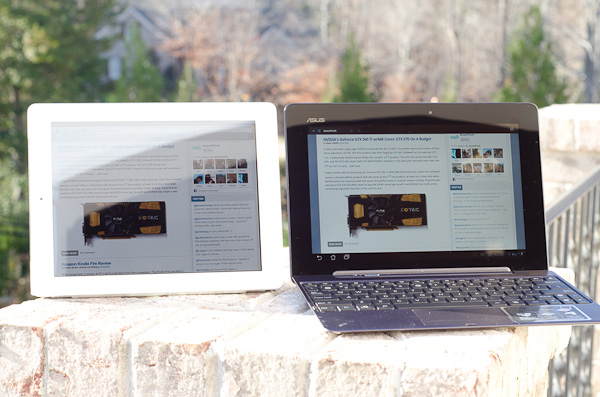ASUS Eee Pad Transformer Prime Review Part II: Battery Life & More
by Anand Lal Shimpi on December 15, 2011 3:45 AM ESTSuper IPS+
I rode around town as a passenger equipped with the Transformer Prime and dock to test out how usable the setup was as a truly mobile platform. Glare is still a big issue if you're in a sunny environment; however, I was surprised to see that even without engaging the Prime's Super IPS+ mode that the display was usable in many cases outdoors. I definitely preferred the experience with Super IPS+ mode enabled though. While the glossy screen picks up fingerprints and is extremely reflective, the 600+ nits the panel is able to put out in its brightest mode definitely overcome both of these concerns.

Color Gamut
Some of you have asked for color gamut charts for the Transformer Prime, which I have provided below vs. the original Transformer:

ASUS Eee Pad Transformer

ASUS Eee Pad Transformer Prime










58 Comments
View All Comments
metafor - Thursday, December 15, 2011 - link
Yes. Since Tegra 3 is actually capable of clock-gating individual cores as opposed to all-or-nothing like Tegra 2, power utilization should be better.That in combination with display local dimming and lower voltage -- since the CPU's are made on 40G -- definitely help brings per-core power down.
The question is whether or not the performance is there to compete with SoC's on Android early next year with Samsung's new Exynos and Krait based devices.
TareX - Thursday, December 15, 2011 - link
Quite off topic, but I expected Anand's Galaxy Nexus review to be out by US launch day...Death666Angel - Thursday, December 15, 2011 - link
Is it now the norm to compare products based on their size rather than ability and, most importantly, price? A Netbook probably retails for $250-$400. This thing retails for $650 (with dock)? I don't see how this in any way compares to a netbook. Sorry.quiksilvr - Thursday, December 15, 2011 - link
It isn't fair comparing the two because the ASUS has a 10.1" screen at 1280x800, not a 9.7" screen at 1024x768. Thats a 0.78MP screen vs a 1.0MP screen. It has to render 20% more pixels and on top of that the screen is larger.quiksilvr - Thursday, December 15, 2011 - link
I'm referring to battery life.Confusador - Thursday, December 15, 2011 - link
Thanks for doing the follow up on this, demonstrating once again why you're the best in the business.Hopefully Asus will learn from this; if you weren't as thorough as you are they would have ended up with their only review here being unnecessarily negative. Maybe they'll give folks more lead time in the future!
fteoath64 - Friday, December 16, 2011 - link
So there is just some improvement and not a great deal of improvement. Wonder if it would be better if Nvidia put two 1.8Ghz cores rather than 4 1.4Ghz core, then the end result in performance would be way better with slight penalty on battery life ?.I guess I have to wait for the A15 cores then!.
Mugur - Friday, December 16, 2011 - link
Asus should've done the impossible and have it ready by Christmas with ICS on it and aggresively priced. It would've been an instant hit.vcarvega - Friday, December 16, 2011 - link
I do think it is commendable of you to update your original review with these updated tidbits. However, I do wonder when it comes to your gripes, particularly with multitasking.I agree with the limitations of Honeycomb's multitasking, but what are we comparing it too? Your review was specifically comparing it to a netbook, so your criticism is fair if we're comparing it to Win XP... but compared to other mobile OS', it's the best on offer (admittedly, I have not tried the Playbook's implementation of multitasking which looks like it may be more comparable to a desktop experience).
Currently, I think heavy users run into serious limitation regardless of which tablet platform they are using. I think I was hoping for quad core to change this as well tho... so that's disappointing. Maybe ICS?
Your comments on higher clocked, dual-core 28nm chips possibly being comparable in performance to Tegra 3 gave me reason to pause as well! Simply b/c I fear that Android 4.0 is still being optimized for dual core devices, not quad core... Because unless things change at CES, most new mobile devices being announced for 2012 still have dual cores!
vision33r - Friday, December 16, 2011 - link
Really bad timing. There are so many phones out right now that makes the Razr look outdated.For starters, this phone doesn't even beat the SSGS2 which came out more than 6 months ago.
Now we have GalaxyNexus Prime, HTC Rezound. Upcoming phones will all have LTE, 720p displays, and better performance.